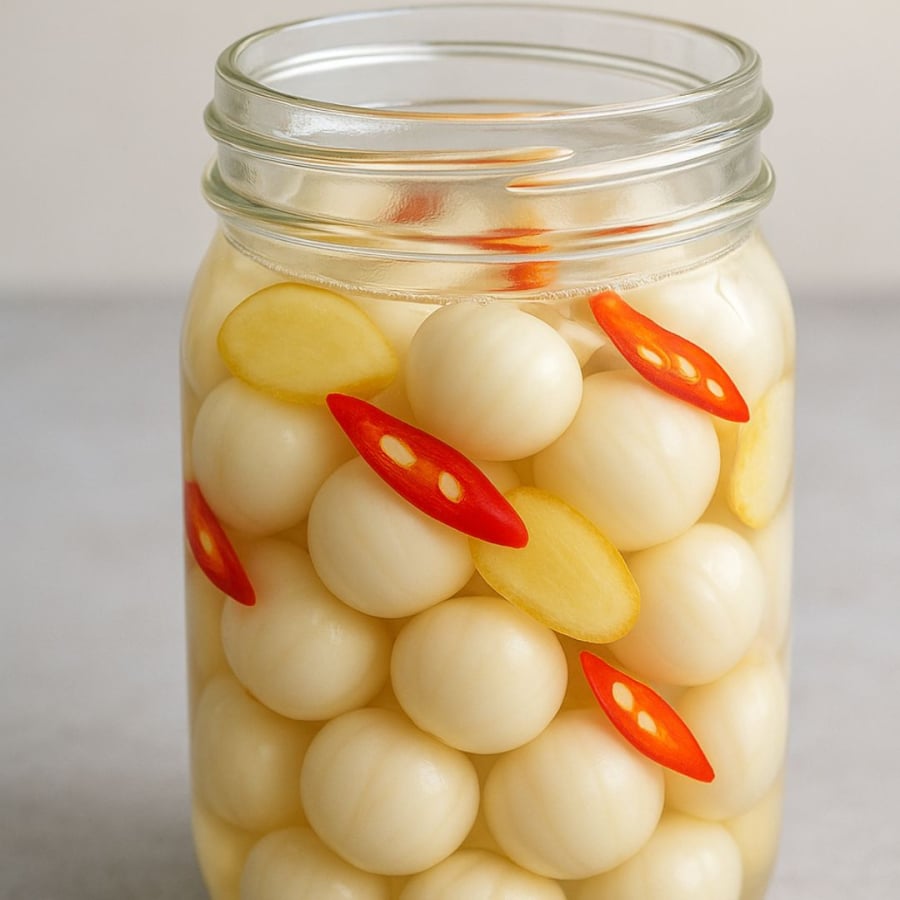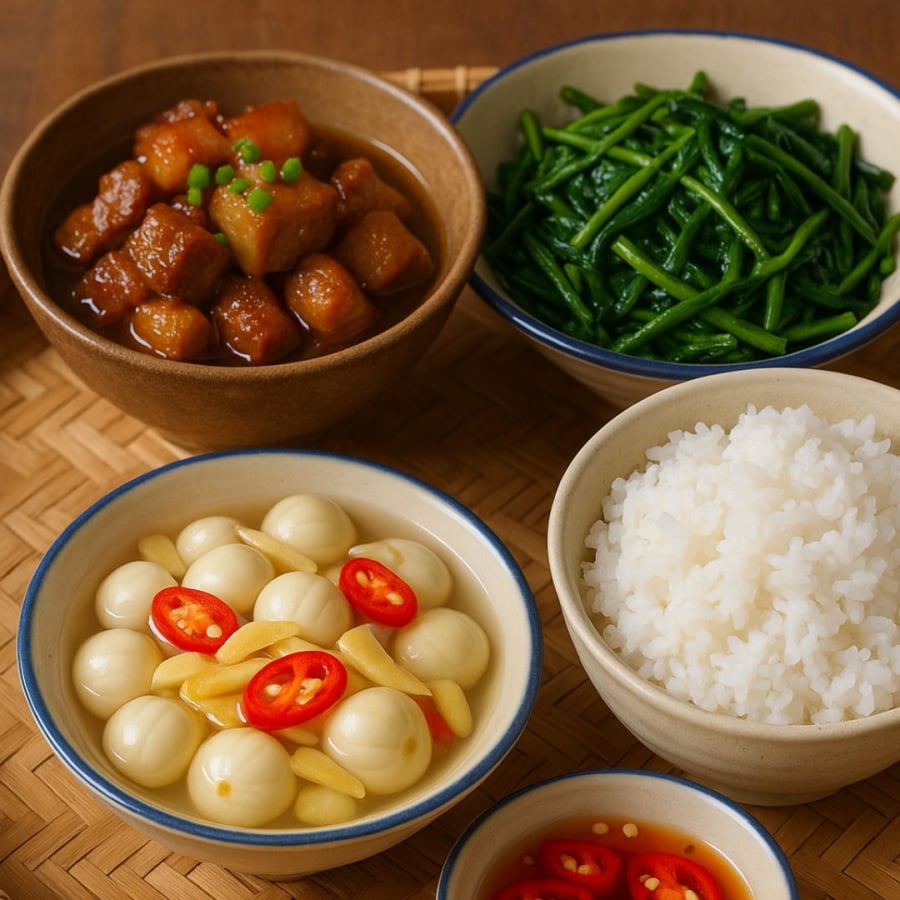In traditional Vietnamese meals, pickled green eggplant is a rustic yet essential dish, especially when paired with crab soup or boiled water spinach. However, not everyone knows how to pickle eggplants to achieve the perfect crispness and avoid discoloration or sogginess. This article will guide you through the process, from choosing the right eggplants to handy tips during the pickling process, ensuring you get delicious, crisp, and aesthetically pleasing pickled eggplants.
1. Selecting the Best Eggplants for Pickling
The key to achieving crisp and tasty pickled eggplants lies in choosing the right ingredients. The eggplants used for pickling should neither be too old nor too young.
How to identify the best eggplants:
- Observe the stem: A small, dry stem indicates an old eggplant, while a large, green, and soft stem suggests an immature one. Opt for eggplants with moderately sized stems that are still fresh but not floppy.
- Feel the eggplant: Older eggplants tend to have thinner flesh, harder and more seeds, and are prone to becoming soft when pickled. Younger eggplants have softer flesh and seeds, making it challenging to attain the desired crispness. Choose eggplants with shiny, firm skin, free from any mushiness.
You can use either green, white, or purple eggplants for pickling. The small white variety with a slight purple hue will turn into translucent white eggplants after pickling, resulting in a crisp and visually appealing treat. The traditional green and white eggplants are also popular and easy to pickle if you know the right techniques.

2. Tips for Pre-treating Eggplants for Crispness
Proper pre-treatment of eggplants is a critical step to prevent discoloration and sliminess during the pickling process.
Pre-treatment steps:
- Sun-dry the eggplants: After purchasing, spread the eggplants in a place with gentle sunlight or cool breeze to let them wilt slightly. Reducing their moisture content will enhance crispness when pickled.
- Trim the stems: Using a sharp knife, gently cut the stem end of each eggplant, being careful not to cut too deep to prevent excessive water absorption, which can lead to sogginess.
- Soak in brine: After trimming the stems, soak the eggplants in a mild brine solution for about 1-2 hours. You may change the water once or twice to eliminate toxic sap, resulting in whiter eggplants with less scum, making them safer to consume.
Additionally, prepare a few slices of galangal and bird’s eye chilies to enhance the flavor of the pickling solution.

3. Mixing the Brine Solution
Another critical factor determining the success of pickled eggplants is the ratio of salt to water in the brine solution.
Here’s how to mix the brine solution:
Use cooled boiled water and mix it with sea salt in a ratio of approximately 100g of salt per 1kg of eggplants.
Note: If the brine is too weak, the eggplants will quickly turn soft, develop scum, and spoil. Conversely, if it’s too salty, the eggplants will be crisp but overly salty, losing their natural flavor and becoming unhealthy. Therefore, the amount of salt should be just right to achieve crisp, white eggplants that are pleasant to eat.
In addition to salt, add sliced galangal, chilies, and some garlic cloves to infuse the eggplants with a delightful aroma and enhance their appeal.
4. Choosing the Right Container for Pickling
The choice of container for pickling is as important as the pickling process itself. It is recommended to use:
Glass jars or ceramic pots that have been thoroughly cleaned and rinsed with boiling water for sterilization.
Avoid using plastic containers as they can retain odors and may not maintain long-term hygiene.
When arranging the eggplants in the container, layer them with slices of galangal and chilies to ensure even flavor distribution.
Important: Use a weight to press down on the eggplants, ensuring they are completely submerged in the brine. Even a single eggplant floating above the brine can cause discoloration and spoil the entire batch.

5. Proper Storage of Pickled Eggplants
After pickling, tightly close the container and store it in a cool, well-ventilated area, away from direct sunlight or high temperatures. Heat can cause the eggplants to soften, losing their desired crispness.
Typically, after 2-3 days, the eggplants will develop a mild sourness and attain the perfect crispness. If you prefer a faster souring process, you can add a small amount of rice vinegar and a little sugar to the brine solution from the beginning. However, be cautious not to overdo it to preserve the natural flavor of traditional pickled eggplants.
Once opened, do not return any leftover eggplants to the container, as this can cause scum to form. Always use a clean spoon or dish to remove eggplants from the container to avoid contaminating the batch.
While it’s not complicated to pickle crisp, white eggplants, it requires attention to detail, from ingredient selection to pre-treatment and brine mixing. With these simple secrets, you can now confidently prepare delicious batches of crisp, white pickled eggplants, free from discoloration and full of flavor. The mildly sour and incredibly crisp eggplants will undoubtedly elevate your family meals, adding a touch of authentic Vietnamese flavor to your table.
“The Ultimate Crab Soup: Unlocking Nature’s Delicious Block”
The key to achieving a perfect crab soup with a firm, solid texture lies in temperature control. Start with a high flame to heat up the pot, and once you notice the edges beginning to warm, reduce the heat to low and refrain from stirring. Additionally, to create a sweet and savory broth with tender crab meat that forms cohesive chunks without any fishy odor, there’s a secret ingredient you’ll need.
The Secret to Cooking a Delicious Crab Soup: How to Make the Meat Float in Chunks and Enhance the Sweet Aroma
Introducing the humble crab, a delicacy often enjoyed during the hot summer months. While crabs are known to dwell in rice paddies and canals, which may raise concerns about harmful bacteria, a simple solution lies in the addition of salt during the pounding process. This age-old technique not only enhances the flavor but also ensures the dish’s freshness and longevity, even during the sweltering heat.



































